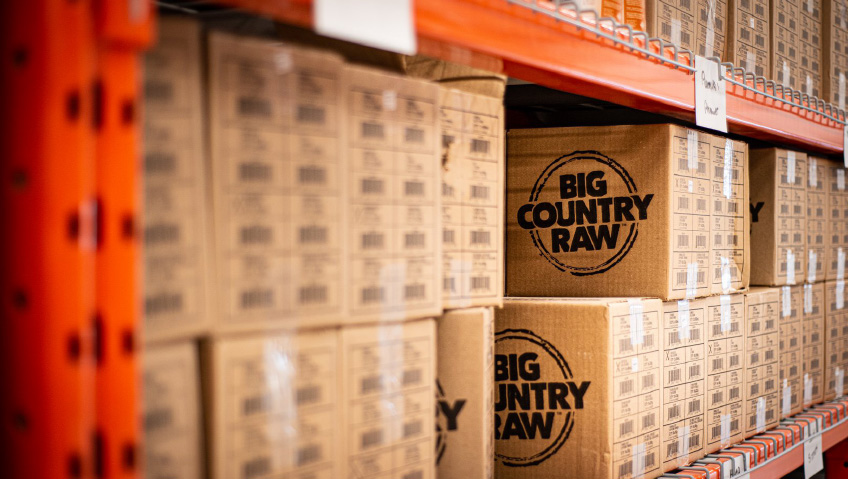In most Canadian homes, pets are considered to be part of the family, and their humans make every effort to care for their wellbeing. Living through a pandemic has changed the way people look at food, with many choosing to eat healthier, less processed foods. This new focus on wellness has also reached the pet food industry.
As trends such as smoothies, juicing, and weekly meal kits continue, there is also a growing market for specialty pet food geared towards improving food quality for our four-legged friends. Dry kibble is highly processed. Some of the best brands use fresh meat as the first ingredient, although many others use meat meal, a mixture of meat, fat, and bones that is cooked down several times before it is condensed into kibble form.
“I always say that over-processing is never good. You derive things from nutrients, and that’s where the idea of raw comes from. It’s just literally as little processing as possible. It means you get the freshest, most bioavailable foods,” says Geraldine Brouwer, owner of Canadian pet food manufacturer Big Country Raw.
Celebrating its tenth anniversary this year, Big Country Raw is providing the pet food industry with frozen complete meals designed for all life stages of dogs and cats. The meals are a combination of meat, bone, organ meat, fruits and vegetables, as well as beneficial vitamins and mineral oils. It also offers pure formulas with the meat, bone, and organ meat alone.
The frozen meal product lines make up roughly eighty percent of the business; the rest is in frozen raw bones and an extensive line of supplements. Vitamin and mineral supplements can help with a pet’s specific health needs, and chewing raw bones is a great way to keep a dog’s teeth clean. Quail eggs, duck eggs, goat milk, and bone broth are also available as frozen supplements.
Big Country Raw’s products are primarily sold in pet specialty retail chains across Canada including Pet Valu, Ren’s Pets and Mondou. A small portion of the business, and one that is just beginning to grow, is its product line called Hungry Hunter, available in PetSmart and select grocers.
Committed to sustainable packaging, Big Country Raw formed a partnership a few years ago with StanPac Packaging, known for manufacturing with sustainable forestry materials. “We have transitioned a large majority of our packaging to paperboard packaging, addressing the fact that we are trying to move away from plastics and look for more sustainable packaging sources,” says Brouwer. “We’re the only Canadian pet food brand right now using paperboard packaging for our container.”
She explains that paper is stronger than plastic and better equipped for storing in the freezer because it does not crack or break. Also, the company’s packaging is approved by the Sustainable Forestry Initiative (SFI), signifying that all of the paperboard used in the making of its containers is from sustainably managed forests. The paperboard packaging transition has had a bit of an education curve for the customers, but Big Country Raw understands that the result is worth the effort.
The team at Big Country Raw is no stranger to raising awareness in the market. When the company first began, one of its main objectives was to educate the public that raw food for pets is not dangerous. Today, raw food has gained a great deal of acceptance, and pet stores are now installing walls of freezers to carry frozen raw products.
Before the raw pet food industry made such big strides in manufacturing, people would prepare their pets’ raw food at home, which can be unsafe. Big Country Raw and other manufacturers are now able to provide balanced, complete, and safe raw diets that were not necessarily available fifteen years ago. Fortunately, the industry has seen much progress and that trend is expected to continue.
Big Country Raw’s growth within this new market has been quite rapid. When it was founded in 2012 by Geraldine and her husband Rob Brouwer, there were only a handful of part-time employees. By 2020, the staff count was at seventy-five, and in the last two years, the number of full-time employees increased to 150.
Headquartered in Smithville, Ontario, a small rural community in the Niagara region, the company has always been very community-focused. It obtains raw material from local suppliers whenever possible, including corrugate from Whitebird, and its duck and turkey suppliers are within an hour of the Big Country Raw processing plant in Smithville.
The pet-passionate employees have the benefit of working for a living-wage employer because Big Country Raw truly cares about the quality of life of the people helping the company reach success. “It’s always about ensuring that there’s a great work-life balance. We have a lot of flex schedules, and we have a lot of families, so a lot of referrals end up coming to work here as friends and family join them,” says Brouwer. “We are proud of the work culture that we’ve created and really proud of the people that work here.”
The leadership believes in a collaborative team approach and is focused on making decisions as a group. “We always say you never work a day in your life if you love what you do. That’s a big part of us choosing people to work here and choosing leadership. People that really love being in the pet space, love pets, and are passionate about how we’re changing lives and changing the pet industry by bringing this kind of product to market,” says Brouwer.
One advantage of partnering with Big Country Raw is its direct distribution model. Usually, in the pet specialty market, the manufacturer sells to a distributing partner, which takes the product and distributes it to multiple brands. When Big Country Raw was founded, this method would not work for the raw category because the pet specialty distributors were not equipped with freezers and the ability to distribute frozen products. These circumstances forced the company to go directly to the store to sell its products, and after ten years in business, it has continued with that model.
Even though the pet specialty retailers are now installing freezers and distributing partners have refrigerated trucks to offer fresh and frozen delivery, Big Country Raw recognizes the advantage of its direct distribution. “We’ve always managed that whole supply chain ourselves. I think it sets us apart because we can keep our costs and our quality in check,” explains Brouwer. “We can improve our quality and keep costs in control because we don’t attach any cost or margin to distribution.”
Direct distribution is also useful in getting feedback about the products being sold. The close contact and communication with retailers has helped Big Country Raw expand its portfolio and offer better services at a lower cost.
In 2020 when people started working from home due to the pandemic, there was a massive increase in pet adoption. Shelters reported that by summer, they had been emptied. This increase in the number of families with pets combined with a new perspective on the benefits of fresh, healthy foods led to more business for Big Country Raw.
“We noticed that there was a ton of traffic on our website, with a lot of people asking these questions and researching raw foods for their dogs and cats. We’ve had a lot of growth through COVID, and our year over year growth exceeded the category growth,” says Brouwer.
The challenges that have come with the pandemic are the unavoidable supply chain issues affecting every industry. Big Country Raw uses novel proteins such as duck and rabbit, and when the restaurants were not operating at their usual pace, these sources of protein were not as accessible because they were not being processed. Now, the company is dealing with inflationary pressures. There have been cost increases on everything from packaging to raw material, making the exit from COVID-19 more difficult.
According to Brouwer, the Canadian pet food industry is ahead of the U.S. in integrating raw products. Although the industry is still in the early stage as far as adoption of raw feeding, with roughly five percent of pet food purchases in raw food, she anticipates that it will grow by fifteen to twenty percent over the next five to ten years.
Big Country Raw’s rapid growth comes with its fair share of challenges and pressure, but the team is excited about the progress being made in the frozen raw pet food space. “It’s like Christmas all year round around here. We’re always on the move,” says Brouwer. “I see our business continuing to grow, and I’m really thankful that there’s this much interest in it. I still love all the stories from people that call and send us messages on social media about how raw has changed their pets’ life for the better. That’s really the reason why we started this; it was just about pets having healthier lives.”
For owners looking to make the transition to raw pet food, it is recommended to start with a graduated approach to ease any digestion discomfort. Also, it is never too early or too late in a pet’s life to switch to a raw food diet. Many people choose to begin with a raw bone for dogs, and then start topping kibble with raw food before offering complete meals. Once they see the difference in their pet’s life, the benefits of feeding raw are undeniable.
Improved joint and bone health, heightened immune system, reduced stool volume and odour, and better dental health are just the beginning. Overall, raw food delivers a higher quality of life for our beloved four-legged family members.
Brouwer concludes with another great reason to make the switch. “Communication is hard with our pets right; they don’t talk to us and we just have to read their emotions. We know when they’re happy or sad, and mealtime is the one time that we can really serve them. It’s just really rewarding to do that with [raw] food.”






